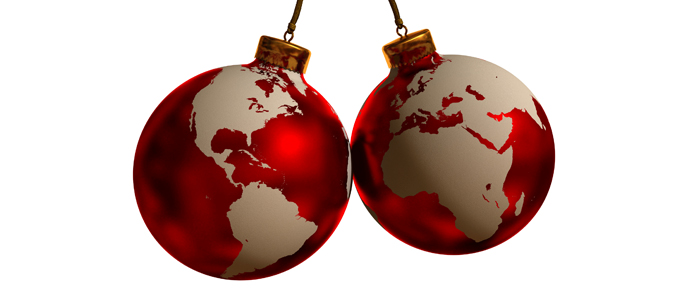
By Haddon Libby
On behalf of everyone at CV Weekly, I want to wish you, your family and those you love a happy Christmas and thank you for reading this paper and my column throughout the year. It is our sincere hope that your holiday is filled with good friends, tasty food, much love and lots of happiness.
Take a moment to reflect and consider using the holidays as an opportunity to banish anger and hate from your life. This includes all of you who are still upset by the results of the recent Presidential elections. Remember that negativity begets more negativity while positivity, love and forgiveness, brings more of each into your life. Make a conscious effort to be nice to everyone. When you feel the need to be negative or make someone else unhappy, go sit in the corner until you are ready to behave toward others as you would have them behave toward you.
With that said, let’s take a trip around the world to see how other cultures celebrate Christmas:
In India, the few who celebrate decorate banana or mango trees while putting small oil burning lamps on their roofs in order to proclaim their faith. There are no records as to how many houses burn down each year as a result.
 Sweden is another place where fire is misused. Swedes celebrate on December 13th (St. Lucy’s Day). Lucy is the girl who brought food to Christians who hid from persecution in the catacombs under Rome. Lucy would wear candles on her head so that she could carry more food on her journeys underground. In honoring Lucy, young women over 13 years of age wear candles on their heads while singing (under 13 get electric candles) at Christmas services. A favorite holiday food is Lussekatt which is a saffron and raisin bun that is eaten for breakfast.
Sweden is another place where fire is misused. Swedes celebrate on December 13th (St. Lucy’s Day). Lucy is the girl who brought food to Christians who hid from persecution in the catacombs under Rome. Lucy would wear candles on her head so that she could carry more food on her journeys underground. In honoring Lucy, young women over 13 years of age wear candles on their heads while singing (under 13 get electric candles) at Christmas services. A favorite holiday food is Lussekatt which is a saffron and raisin bun that is eaten for breakfast.
 Ethiopia follows the Julian calendar and celebrates the holiday called Ganna on January 7th. On Ganna Eve, people fast. The next morning, people dress in a traditional white garment called a shamma that is worn like a toga while attending services. The traditional food that is served is called wat which is a spicy stew made of meat, vegetables and eggs served with flat bread. Presents are not typically exchanged.
Ethiopia follows the Julian calendar and celebrates the holiday called Ganna on January 7th. On Ganna Eve, people fast. The next morning, people dress in a traditional white garment called a shamma that is worn like a toga while attending services. The traditional food that is served is called wat which is a spicy stew made of meat, vegetables and eggs served with flat bread. Presents are not typically exchanged.
Like Ethiopia, Egyptian Christians follow the Julian calendar and call this holiday Kiahk. For the forty-three days leading up to Kiahk, people eat a vegan diet. On Kiahk, people indulge and eat all of the things that they could not over the previous six weeks. Santa Claus is called Baba Noel.
Iceland calls Christmas Yule. For the thirteen days leading up to Yule, Yule Lads (troublemaking imps) like to play tricks on people. These lads have names like Gimpy, Pot Licker, Bowl Licker, Door Slammer, Yogurt Eater, Sausage Snatcher, the creepy Window Peeper, Meat Hooker and Doorway Sniffer. Celebrations begin at 6pm on Yule Eve as 6pm used to be the start of a new day in Iceland (their version of midnight). Christmas is celebrated with a meal that includes a leg of roast lamb, a game bird called a rock ptarmigan and fried bread. Until recently, Icelanders added extra flavor to their lamb by smoking it over coals and sheep dung. YUM!
In Japan, Christmas is viewed as their version of our Valentine’s Day where couples spend the day together and exchange presents. The favorite meal is fried chicken finished with a strawberry and whipped cream-filled sponge cake.
The 1% of the Chinese who celebrate, decorate plastic trees with paper ornaments and give wrapped apples to each another.
Happy holidays!
Haddon Libby is a Financial Advisor and Managing Partner at Winslow Drake and can be reached at 760.449.6349 and HLibby@WinslowDrake.com.











































